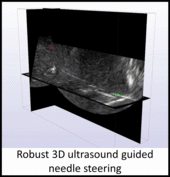
Many percutaneous procedures are used to reach clinical targets for diagnostic (e.g. biopsy) or therapeutic (e.g. drug injections) purposes. Most often, medical images such as X-ray or ultrasound (US) provide information to the physician about the needle and target locations. Needle flexibility, image quality, biological tissue variability and limited ability to control the needle trajectory, are challenging and motivate the development of image-guided robotic approaches. In this paper, flexible needles with asymmetric tips are used to follow complex 3D paths to preplanned targets.
We have developed a needle steering approach for US-guided percutaneous procedures. This includes tracking the needle and the target, planning a path to the target and controlling the needle motion in real-time. In order to face the low quality of images, the high variability of biological tissue and the limited ability to efficiently model the needle-tissue interactions, a module exploiting image and robot information is used to estimate and predict the needle behavior based on observations. Such a module handles tissue heterogeneity and uncertainties to achieve a robust steering.
In this paper, we describe the different components of this system and the way they interact in order to produce 3D helical paths with variable curvature. We also show how different constraints (such as distance to the obstacles or needle visibility) can be handled simultaneously. The experimental work was performed using multi-material phantoms and ex vivo biological tissue. Targets have been reached by Nitinol needles with a mean error of less than 1 mm in homogeneous phantoms, 1.5 mm in heterogeneous phantoms and 1.7 mm in ex-vivo tissue.

